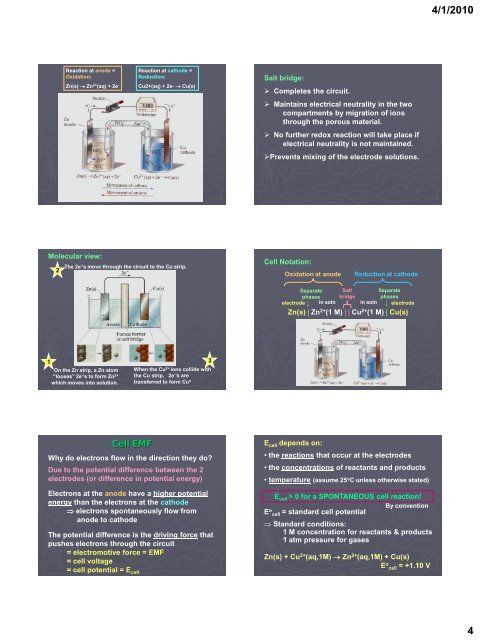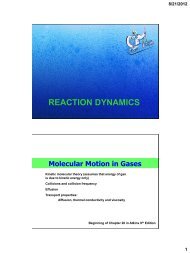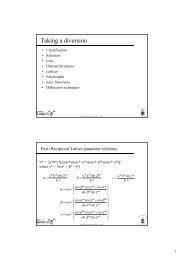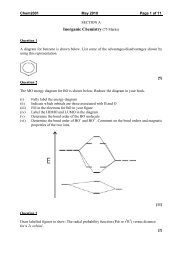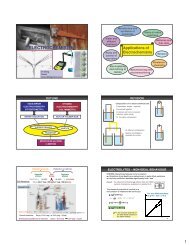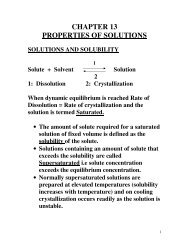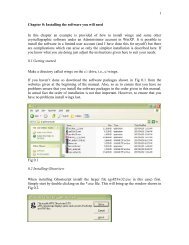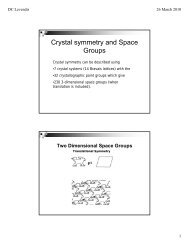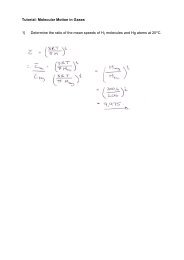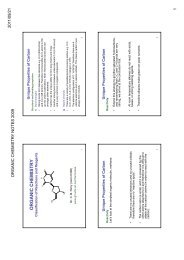ELECTROCHEMISTRY - Wits Structural Chemistry
ELECTROCHEMISTRY - Wits Structural Chemistry
ELECTROCHEMISTRY - Wits Structural Chemistry
You also want an ePaper? Increase the reach of your titles
YUMPU automatically turns print PDFs into web optimized ePapers that Google loves.
4/1/2010<br />
Reaction at cathode =<br />
Reaction at anode =<br />
Zn(s) Zn 2+ (aq) + 2e - Cu2+(aq) + 2e- Cu(s)<br />
Oxidation:<br />
Reduction:<br />
Salt bridge:<br />
‣ Completes the circuit.<br />
‣ Maintains electrical neutrality in the two<br />
compartments by migration of ions<br />
through the porous material.<br />
‣ No further redox reaction will take place if<br />
electrical neutrality is not maintained.<br />
‣Prevents mixing of the electrode solutions.<br />
Molecular view:<br />
2<br />
The 2e - ’s move through the circuit to the Cu strip.<br />
Cell Notation:<br />
Oxidation at anode<br />
Reduction at cathode<br />
Separate<br />
phases<br />
electrode in soln<br />
Salt<br />
bridge<br />
Separate<br />
phases<br />
in soln electrode<br />
Zn(s) Zn 2+ (1 M) Cu 2+ (1 M) Cu(s)<br />
1<br />
On the Zn strip, a Zn atom<br />
“looses” 2e - ’s to form Zn 2+<br />
which moves into solution.<br />
When the Cu 2+ ions collide with<br />
the Cu strip, 2e - ’s are<br />
transferred to form Cu o<br />
3<br />
Cell EMF<br />
E cell depends on:<br />
Why do electrons flow in the direction they do<br />
Due to the potential difference between the 2<br />
electrodes (or difference in potential energy)<br />
Electrons at the anode have a higher potential<br />
energy than the electrons at the cathode<br />
electrons spontaneously flow from<br />
anode to cathode<br />
The potential difference is the driving force that<br />
pushes electrons through the circuit<br />
= electromotive force = EMF<br />
= cell voltage<br />
= cell potential = E cell<br />
• the reactions that occur at the electrodes<br />
• the concentrations of reactants and products<br />
• temperature (assume 25 o C unless otherwise stated)<br />
E cell > 0 for a SPONTANEOUS cell reaction!<br />
By convention<br />
E o cell = standard cell potential<br />
Standard conditions:<br />
1 M concentration for reactants & products<br />
1 atm pressure for gases<br />
Zn(s) + Cu 2+ (aq,1M) Zn 2+ (aq,1M) + Cu(s)<br />
E o cell = +1.10 V<br />
4


